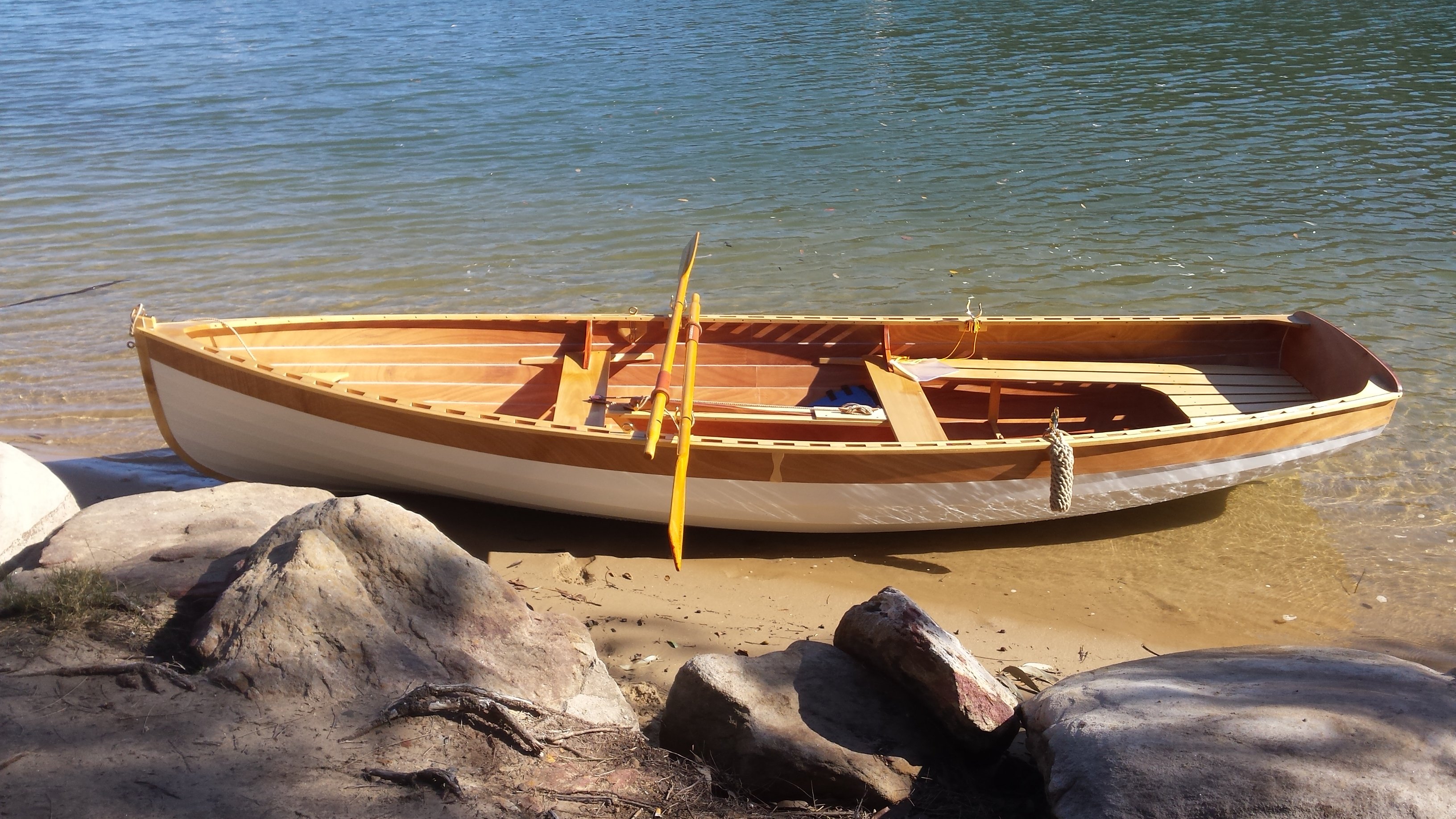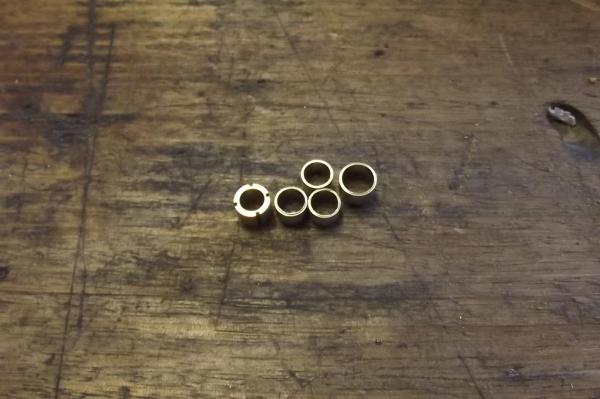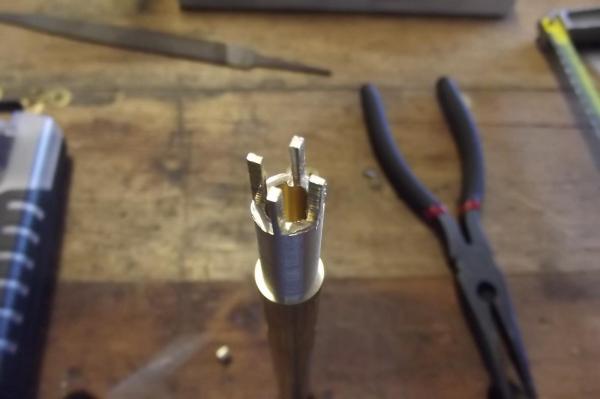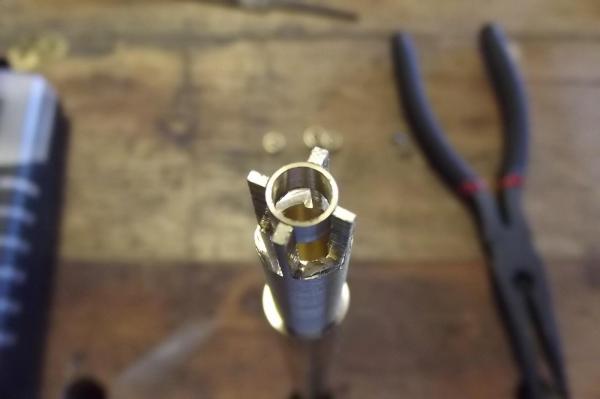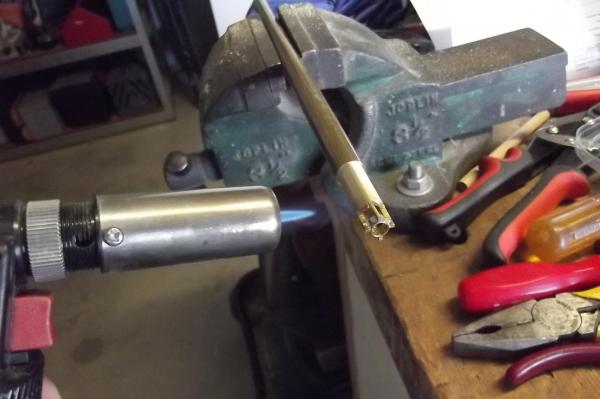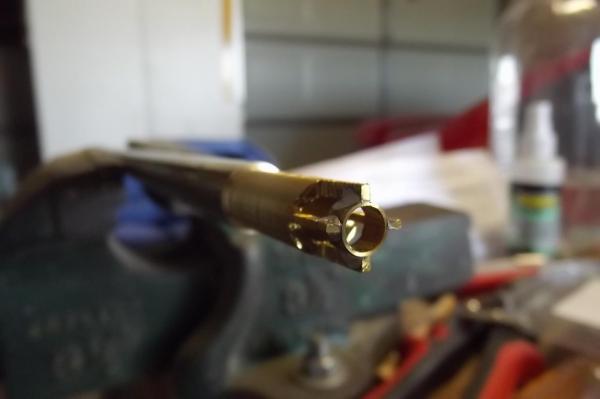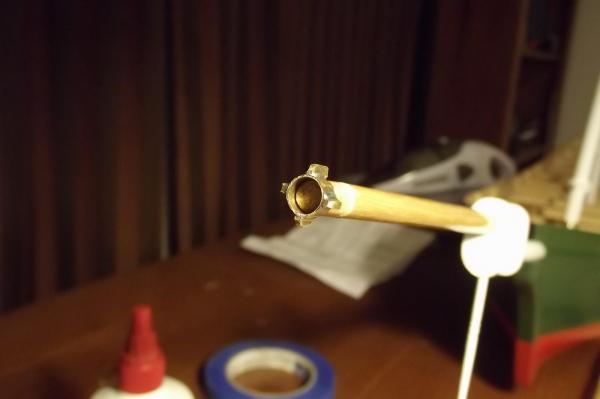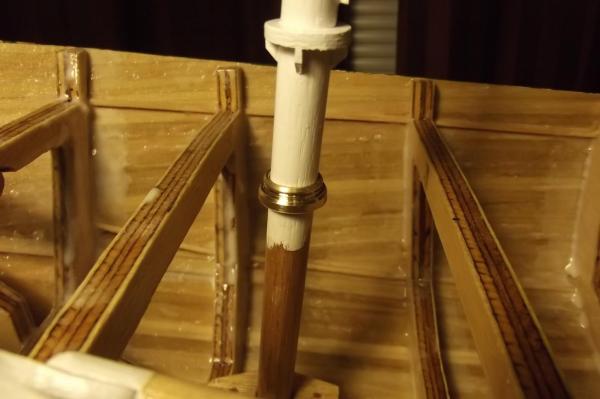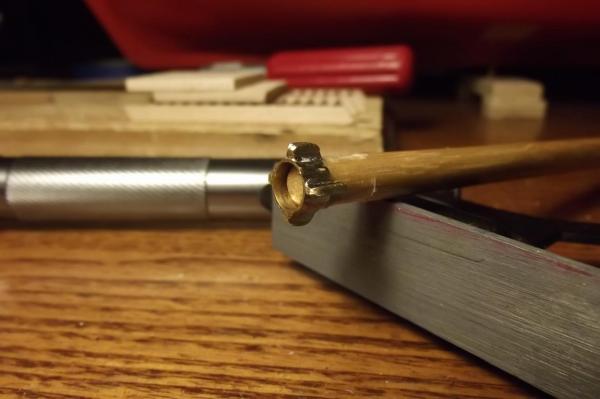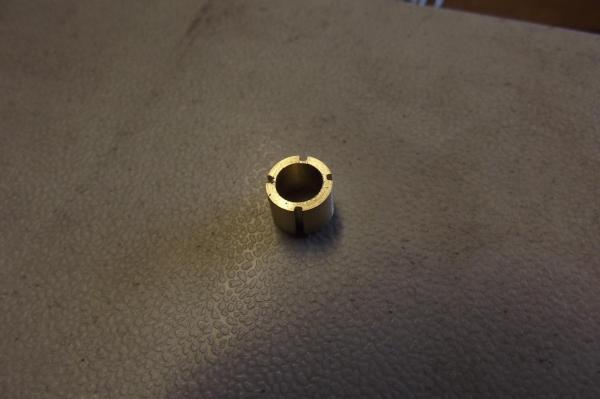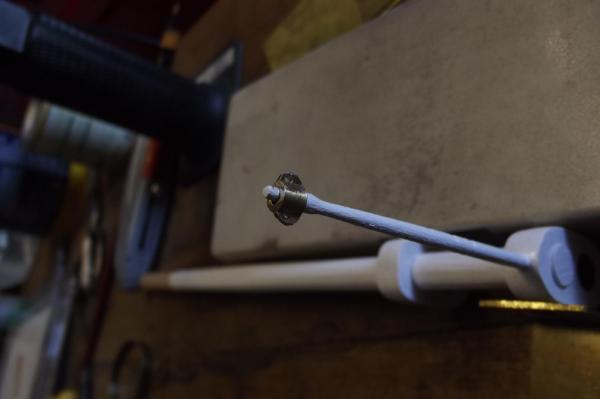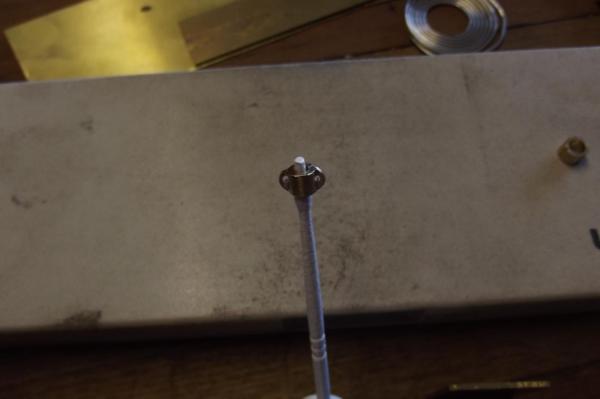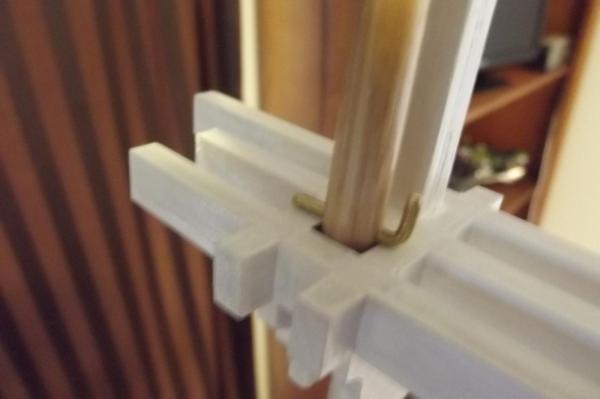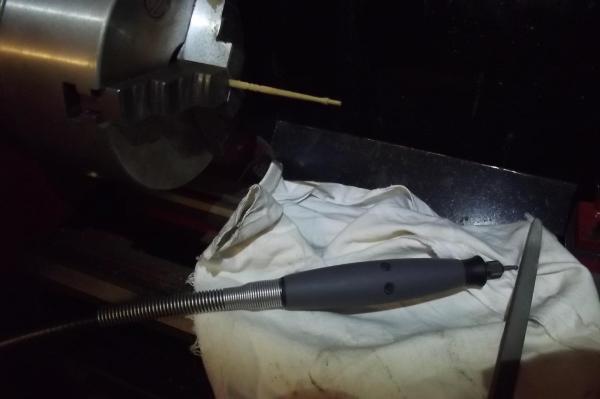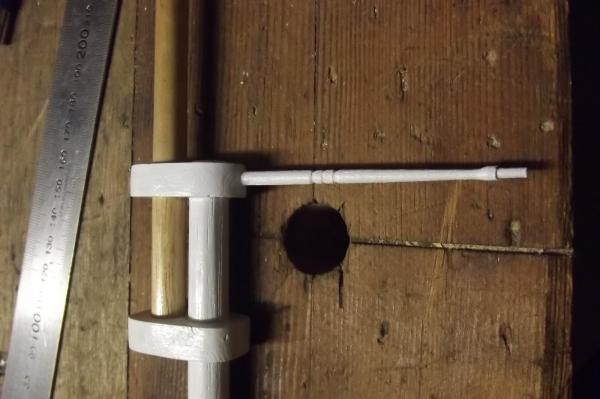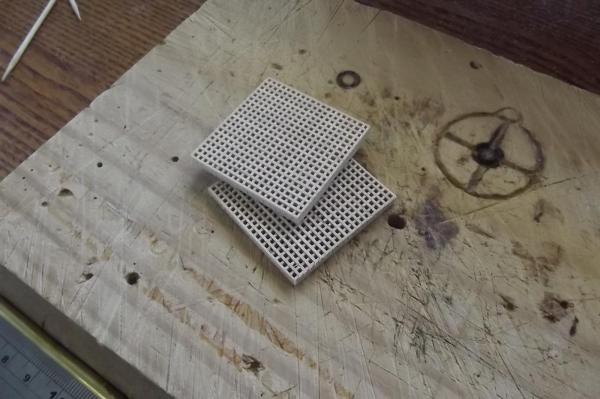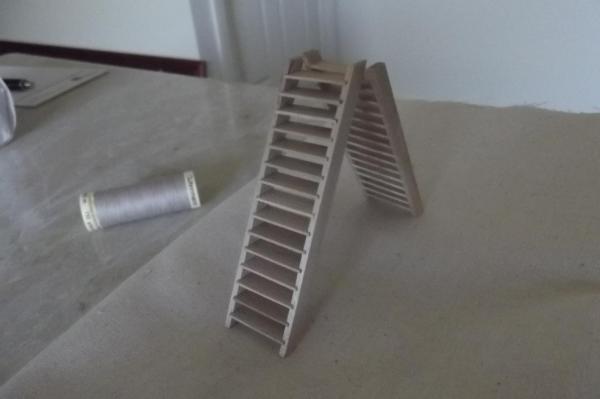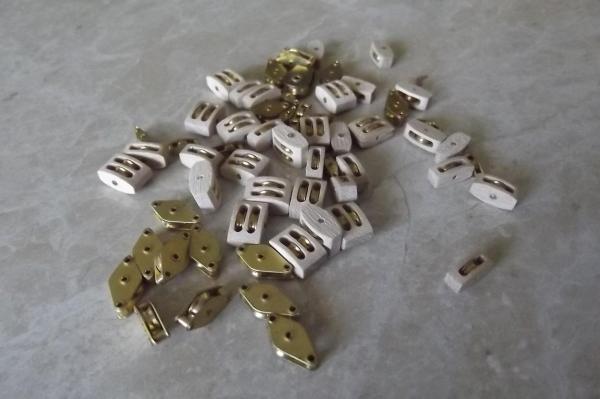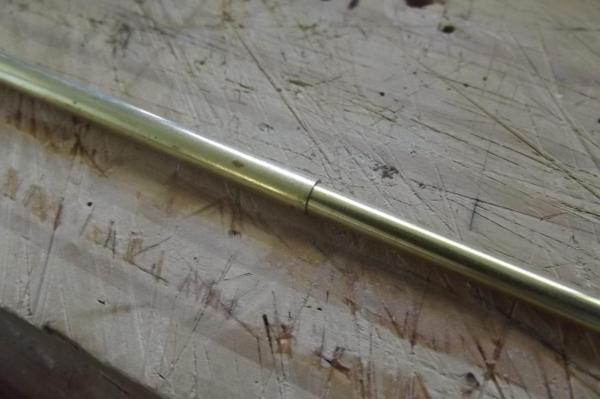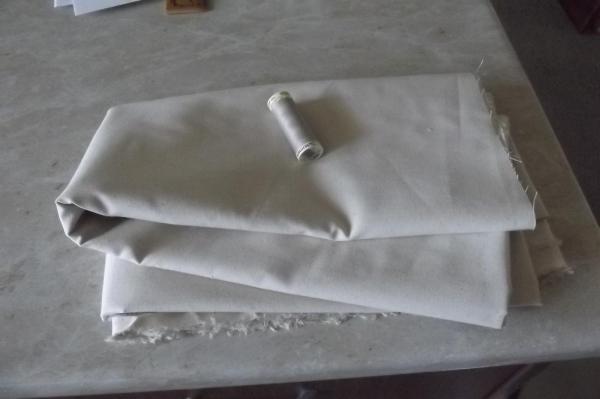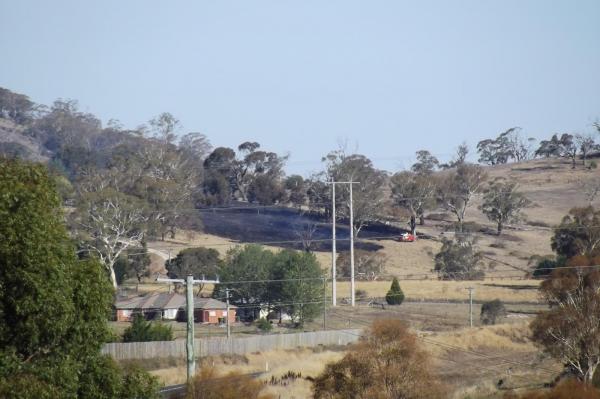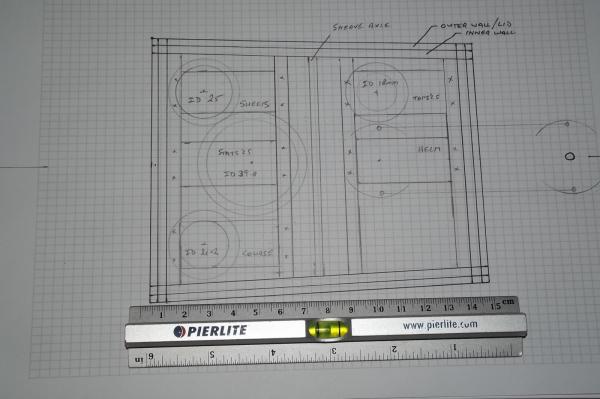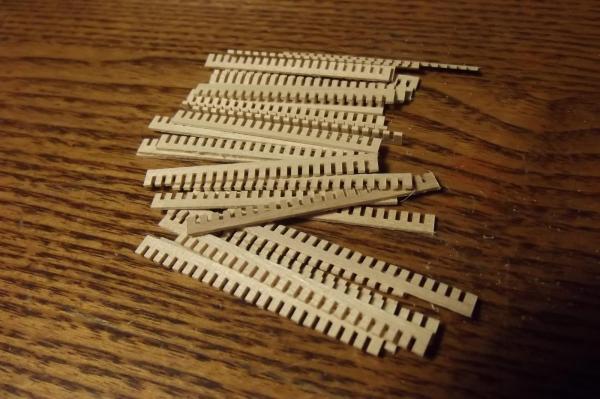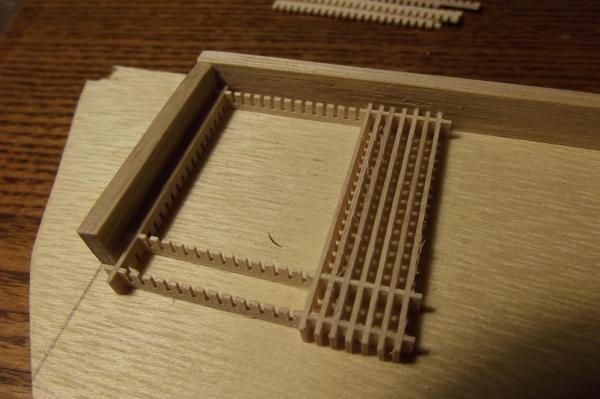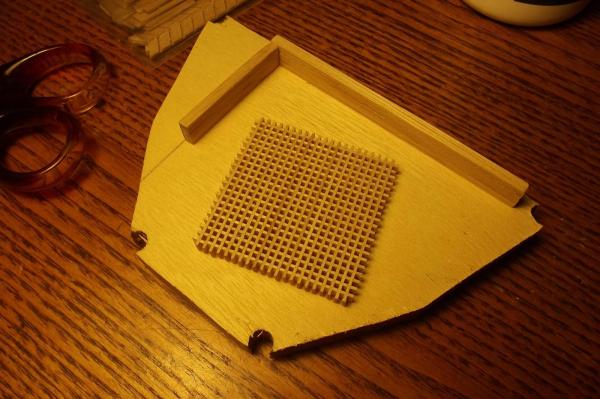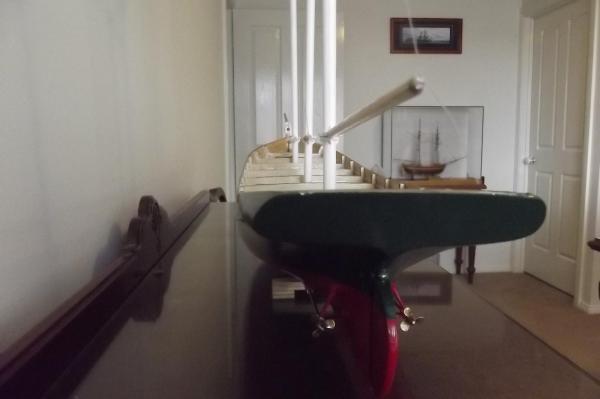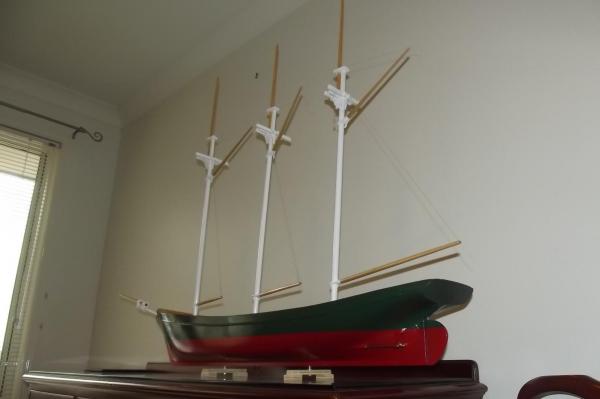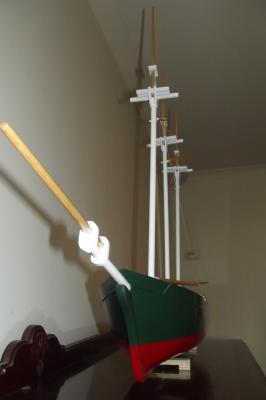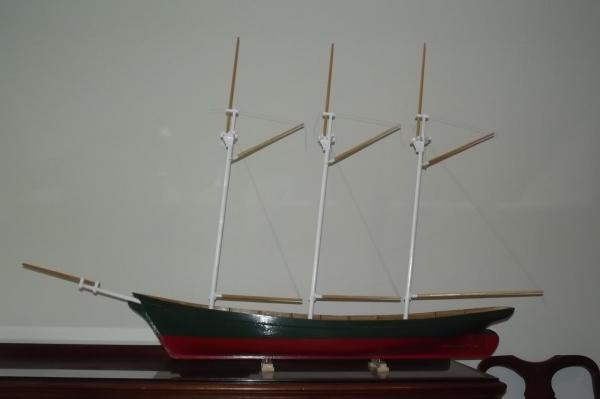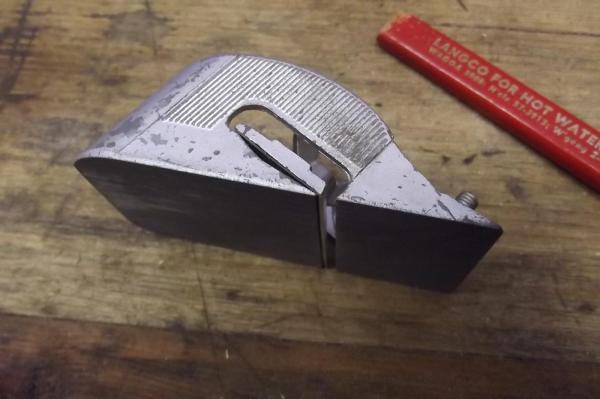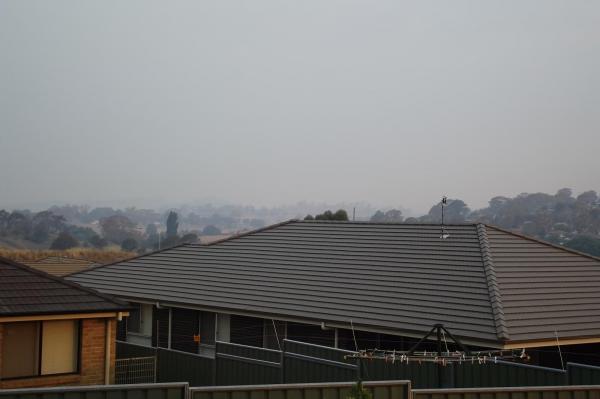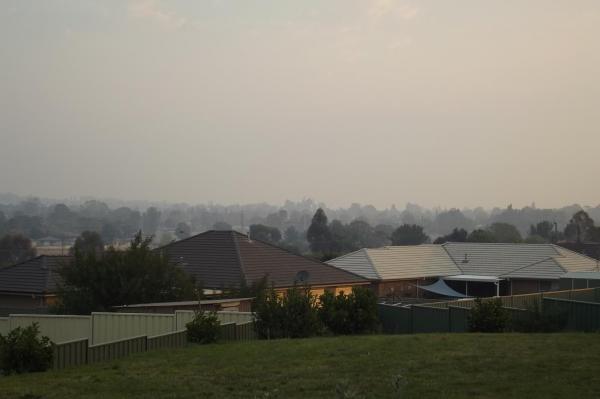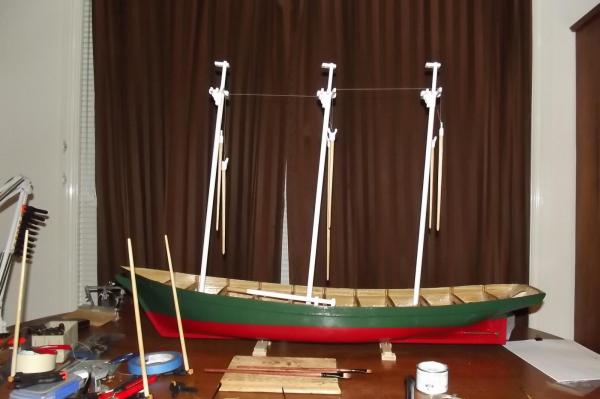-
Posts
1,284 -
Joined
-
Last visited
Content Type
Profiles
Forums
Gallery
Events
Everything posted by Bedford
-
I got some more brass today and I am enjoying working with it. So this is how I made the collars, I have not made a kit for a few years and since this isn't a kit I have nothing to remind me of the correct names. First pic shows one of the original collars with the grooves cut into it to accept the eyes and hold them while soldering. This didn't work because they were too unstable and the eyes kept falling away so I came up with a better way which needed a larger diameter brass. It also meant that because I wasn't cutting grooves into the collar I could make them thinner as you can see in the pic. Three smaller ones for the top masts and one larger one for the bow sprit jib boom. So, first step, in the lathe drill out to 5.5mm internal diameter then turn down to 6.5mm external diameter to get the collar, then using larger stock drill it to 6.5mm internal diameter and turn down to 10.5mm external diameter thus leaving a cylinder with walls 2mm thick. Then remove the stock from the lathe and secure it in the vice with the machined end facing up and carefully cut down into it with a hacksaw twice, once either side of centre with approx 1.5mm between the two cuts then rotate the piece 90degrees and repeat. Once the four vertical cuts have been done cut horizontally into the piece which is to be removed, just a bit, then using long nosed pliers take hold of the scrap and bend it outward til it breaks off leaving this. insert centre section and solder The reason the "legs" are longer than they need to be is to stop the heat from the gas torch going into the stock too quickly which would make soldering difficult because I would have had to apply much more heat. Note in the above pic the bright blue part of the flame, the very tip of that is the hottest part of the flame so you want that to be just touching the job as you heat it. Now for those who think soldering is difficult and needs special fluxes etc, this really is not the case. I am using 40/60 resin cored solder. It is stonger than the normal 60/40, ie 60% lead and 40% tin and requires more heat but not so much as to need special equipment. I just use a hand held butane torch. The secret to successful soldering is cleanliness. All surfaces here were freshly machined without any cutting lubricants and I kept handling to a minimum to avoid contamination from touching. Heat the opposite side to that being soldered where possible as solder runs to the heat. Apply heat for a little while then remove the flame - VERY IMPORTANT - if you leave the flame there it will burn the resin which polutes the surface. After removing the flame touch the solder to the joint and see if it melts easily, if so only a little is required and it should run into the joint, you may need to apply a little more heat to encourage it to run. I just worked my way around the piece doing each side of the tabs and when done I applied the flame directly to the solder for just long enough to melt it and then gently ran an old paint brush over it quickly to remove the excess solder. Molten solder will splatter so be careful where you do it. A bit of a sand with the dremel and Robert's your mother's brother. I still need to drill the holes. A little bit more brass work
-
I have had a very frustrating day of ship building. I am trying to make the eye collars for the bowsprit and top masts but the mill bits I have are no use in this application so I decided to turn the collars to size then slit them using the fine cutting blade for the dremel in the mill as a slot cutter. The idea being that I could cut oversized eye pieces and stand them all up located in the slots and solder with a gas torch but even the light touch of the melting solder proved to destabilise the whole thing so it was a write off. I ended up turning the collar first and centre drilling it to the size to fit the timber, the external diameter is approx an extra 2mm to give a 1mm wall to the collar then machining the eyes in a way that is too hard to understand from text so when I do the next ones I will take pics to show how I did it. I need to get a larger diameter brass first though.
-
Yes John, sometimes when I am stalled trying to work out how to do something I just get stuck into part of the job and it all seems to just fall into place. Robbyn there are smaller hobby lathe/mills around which may be better suited to fine modelling, it depends on what you see yourself making with it, but it is a brilliant thing to have, having said that I still taper my masts etc with a plane and sand paper. Steve
-
OK Robbyn, and Jim Lad. I have got off my design chair and done a little work today, just for you The first pic is a bit out of focus but you can see well enough the pins I have installed to locate the top masts in the raised position. Then I made the dolphin striker in the lathe, this is a very delicate operation because the thin piece of timber is so easy to break. First I gently turned the end down to 2mm diameter to accept the rigging hardware that I will make soon. Then using the Dremel and a bur bit while turning the piece I made the taper roughly. Then I used sandpaper wrapped around a piece of flat timber to smooth out and complete the taper. This whole process was done using my finger against the opposite side of the work as a sort of travelling steady to stop it from breaking. Then I used a triangular file to work the grooves into it. Dolphin striker fitted and first coat of paint.
-
That's OK Robbyn, keep pushing, the new job and extreme heat we are experiencing are combining to knock the wind out of my sails on this build. There are lots of little things that can be done and I am being a bit slack, days and days of scouring the 'net to find parts have left me a bit burned out too.
-
Hmmmmmmmmmmm, I'll try not to be too technical then, you see the hypotenuse of the clew on the fore top stays'l is exponetially influenced by the amout of rum that is gone, why's the rum always gone? Seriously though, while the maritime engineers ague between himself as to which is the best way to effect certain applications of force and leverage and the procurement officer is frantically trying to fullfil the engineers requests the shipwrights have been stood down. There are some things that lie where they left them like the almost finished grates, they just need to be cut to size when the helm is in place. The stairs which are waiting to be cut to size to provide safe access and egress to the quarter deck and fo'csle. A bunch of blocks...... A whole lot of plumbing, the running rigging will run in pipes below decks so I have a handful of 5/32 round brass tube which suits the K&S bender and one length of 3/16 tube which is a lovely fit over the 5/32 and will be cut into short lengths and used as couplings where needed and soldered into place. The sails have also arrived, in kit form! This will test my feminine side, I have mums old sewing machine and a head full of half knowledge I gathered while married, my ex made some very nice quilts etc. After a lot of web searching I think I have the sail winch servos on their way to me, they are all 6 turn servos but can be set to exactly how far I want each one to turn so I won't have to turn bespoke drums for each of them, I will still need to turn the complex drum for the stays'ls though. I will however need to redesign my aft deckhouse layout a bit but no biggie. On an unrelated note, this was a little close to home as they say, glad they got on top of it very quickly.
-
The lengths we will go to............. I do admire the way you think though, if it won't fit the bottle make the bottle fit the model. It should be worth it. Steve
- 170 replies
-
- ogallala
- praire schooner
-
(and 2 more)
Tagged with:
-
Thanks Bob, I get the feeling we have a simmilar view to things like this. Don't get too anxious to see her under sail, there is a long way to go yet. As I said before, if you see me doing something that really won't work then by all means say so. All the tips and advice I have been given have been very helpful and having you, Floyd and Jerry along for the ride has really made a difference. I like to do it my way but I'm not stupid so I take all suggestions on board and process them. Steve
-
I've just been through this whole build thread, must say I'm impressed. Very nice work Michael. I find it particularly useful as a practicum for utilising the lathe/mill, mine is not of the quality of yours and I don't have many tools etc for it but seeing what you can do is really getting me thinking. Steve
- 2,207 replies
-
Ahh this is because I think outside the square. Because I build from complete scratch, ie no previous knowledge and no-one to learn from, I do it with a completely open mind. I thought all this out long before my first post so while people on here influence the build and give good ideas to make things better and easier the bones and core controls of her are always my way. Putting the servos up in the deck houses has a few benefits. They are easier to get to. They are high enough that a sealed radio box is not required because if water ever gets to them I will have bigger worries than fried servos as she will be on her way to the bottom. The deck will be able to be permanently attached with below deck access via cargo hatch to the only things down there, the motors and battery. Floyd told me about a kit schooner of the same size which I posted a link to a while back, she is lousy for scale appearance and is really designed to look good sailing at a distance, the point is she weighs in at 2.7kg wet and mine will be 5.7kg wet so having a few servos up at deck level will not be a problem for my schooner. I am a problem solver and this is why I am building this, to give myself problems to solve. Others build yachts to do club events or tall ships to sail but I am building a working model that will sail, if you see the difference. I'm about making a working machine. She may not sail as well as others but that isn't why I am building her. Early in this thread you see a pic of the back of my Land Rover with an r/c one inside. It was the same thing, I got the body then scratch built the rest, from the hand made aluminiun chassis to all the suspension linkages, bull bar etc. All scaled off my 1:1 in that case and it drives like the 1:1 as a result. Others don't.
-
This is the big planning stage, making sure I get all the controls right. I have worked out which types of servos I need for all but the stays'l sheets but that will be in the fore deck house. I have worked out the aft deck house and will make it as inner walls that are part of the ship and then the deck house will fit snuggly over it forming a lid for the radio conpartment. The servos will screw down to beams fitted at deck level, the outer beams will be glued to the fore and aft walls of the deck house while the inner beams, along with the sheave axle will be srewed down so they are removable to allow greater acces below the deckhouse. All the winch servos will only have one in and one out line with the exception of the stays'l winch which will have three in and three out. This is because each stays'l has a different length of pull to raise and lower it so there will be three different diameter drums. The lines will go over sheaves turned from either delrin or brass which will be spaced along the sheave axle, because the stays'l winch will have three lots of lines, one above the other, I will turn larger diameter sheaves to keep the feed level with each drum. The lines will then go below to spring tensioned individual blocks where they will turn forward into tubes that will guide them to their respective destinations. Well, that's the plan.................
-
Bob, use the force............... Or, round it you will ! Loving this build Bob.
- 420 replies
-
Were I an insecure man I would have to stop following this build, it could make me feel incredibly inadequate
- 662 replies
-
- bonhomme richard
- frigate
-
(and 1 more)
Tagged with:
-
Small update, I made one of the grates for the helm, as I said before, the quality is much better than expected for the price. All the cuts are clean and acurate and the timber has a fine grain so not much splintering although there are a few "hairs". I made a right angle fence to make the grate against. All the pieces just slipped straight into position.
-
Thanks, I love looking at her, she feels right. Yes Robbyn the masts and bowsprit will stay white, with a lot of ships of this era the masts were made of iron and therefore painted. The James Craig is a good example of this although in her case because she is a barque she has the fore and main made of iron and painted while the much smaller mizzen is timber. The top masts and bowsprit jib boom will stay varnished. One of the reasons for the iron masts and often the yards, is that they were the ships' cranes and iron was more reliable and stronger than timber. Top and top gallant masts and yards were still timber. I hope my hardware turns up soon, it's driving me nuts not being able to do anything to her. Steve
-
I wish I had more to post but between starting a new job and feeling drained because of it and hardware not showing up I have not been able to do much. I have received wooden stairs and gratings from an ebay supplier in the UK, better quality than I have had from model suppliers for a more money so I am very happy with them. All I can do is dry fit things and see how she will look so here are a few new pics.
-
Blade you don't need a lot of tools, they just make it easier, My first was done with a hobby knife, a set of small files, razor saw which is a small saw like a tennon saw with a very thin blade, a small mitre box for cutting 45deg angles and the most useful tool of all I reckon, a razor plane. Oh, a handful of different grades of sandpaper too
-
Australian bush fires are like no other because our bush is designed to burn, a lot of it has to burn to release seeds. Trouble is the greenies won't let the required controlled burns be carried out as much as they should like the aboriginals have done for 40000 years so when a fire does break out there is so much fuel on the forest floor it is like hell. Anyway, back to the topic at hand, no updates because I am still waiting for hardware.
-
There are two reasons I chose this type of ship. One, her lines, who can argue? Two, SYMETRY. All masts are the same height and rake, I am going for standoff scale so all gafs are the same length and set at the same angle therefore all tops'ls are identical and can be controlled as one. I will set all booms at the same angle as well and as long as I attach the sheets and lazy jacks at the same distance from the mast on all of them then they will all be identical as far as controlling them goes so they will be controlled as one so I don't have to do a lot of adapting and tensioning, I will only have to do it once for each set of sails. Not sure about the lazy jacks for the stays'ls yet but I'll sort them out one way or another.
-
Jerry, it's all about the challenge my friend so I will try and make her work the way I want. There will actually be 10 to 12 litres worth of space below decks and all I have to put in there is two motors and a battery pack. I can cut out rib sections as required but won't have to do much I think. it is just a matter of guiding some halyards etc and remember her displacement will be 5.7Kg so weight is of no concern at all. As Donald Sutherland said in Kelly's Heroes "Have a little faith Moriarity, have a litte faith"! Michael, thank you I knew someone would help me with that one. Steve
-
Yeah blade, it isn't really that hard, I've built a few kits so I now how it all goes together. Being scratch built only means I have to select the timbers and fittings myself and cut everything myself. In this case it helped that I know how they are rigged because there was nothing in the plans about that. Bob, you're the man. That is my plan exactly. The halyard will be a closed loop so as the gaf is drawn up the slack side of the halyard will run out with the sail, I know there will be a name for the lines that run out across a sail for the purpose of gathering it when it is taken in, somebody? when I haul the gaf down that side of the loop will pull and the sail will be attached to it at several points as it was in the real thing. I am only planning one pull per sail as the forward edge is controlled by its attachment to the mast. I just hope the mizzen sail isn't too big for this to work. I have measured both sides of each pull against my half scale plan and there will only be 20 or so mm variation in the pulls so a single block on a spring below decks on the haul down side of the loop should take care of that. Floyd, the tops'ls will be drawn in and out via a block on the end of the gaf and have the same closed loop as the sails below so they will gather against the top mast. The stays'ls will again employ a closed loop but I am not yet sure how they will go. I am not going to use a commercial rc sail cloth, I have read about a bloke in the U.S. that has a Grand Banks schooner ( like Bluenose) with masts 6 feet tall and uses cotton for the sails. Thats what I am thinking for this, maybe a nylon that is like cotton or even scotch guarding the cotton to try and reduce its propensity to absorb water. Using this kind of fabric will allow sails to raise and lower as well as allow me a bit of colour choice, harking back to the James Craig, her sails are a light grey. Well there you go, I have given away all my secrets ! Floyd, thanks to your input I have reduced the number and type of servos I will use to :- rudder, sail tacking, stays'l tacking, halyard, tops'l halyard, stays'l halyard and motor control. I will need 7 channels. Due to the length of throw that will be needed I have opted for a drum winch servo to tack the sails while needing a horned servo to tack the stays'ls, this will go in the forward deck house which should have plenty of room for it. The rest will go in the rear deckhouse depending on available room in the forward one after setting up the stays'l control.
About us
Modelshipworld - Advancing Ship Modeling through Research
SSL Secured
Your security is important for us so this Website is SSL-Secured
NRG Mailing Address
Nautical Research Guild
237 South Lincoln Street
Westmont IL, 60559-1917
Model Ship World ® and the MSW logo are Registered Trademarks, and belong to the Nautical Research Guild (United States Patent and Trademark Office: No. 6,929,264 & No. 6,929,274, registered Dec. 20, 2022)
Helpful Links
About the NRG
If you enjoy building ship models that are historically accurate as well as beautiful, then The Nautical Research Guild (NRG) is just right for you.
The Guild is a non-profit educational organization whose mission is to “Advance Ship Modeling Through Research”. We provide support to our members in their efforts to raise the quality of their model ships.
The Nautical Research Guild has published our world-renowned quarterly magazine, The Nautical Research Journal, since 1955. The pages of the Journal are full of articles by accomplished ship modelers who show you how they create those exquisite details on their models, and by maritime historians who show you the correct details to build. The Journal is available in both print and digital editions. Go to the NRG web site (www.thenrg.org) to download a complimentary digital copy of the Journal. The NRG also publishes plan sets, books and compilations of back issues of the Journal and the former Ships in Scale and Model Ship Builder magazines.

